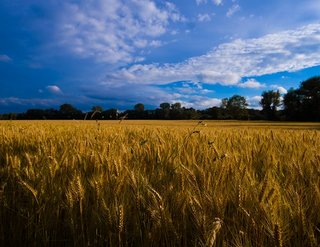The Sr35 gene protects the wheat ancestor einkorn against black rust. The research team led by Alexander von Humboldt Professor Jijie Chai and Professor Dr Paul Schulze-Lefert at the University of Cologne and the Max Planck Institute for Plant Breeding Research in Cologne, as well as Yuhang Chen from the Chinese Academy of Sciences, has decoded the spatial structure of the wheat protein Sr35, discovering that it forms a huge protein complex in the grain’s immune response. This explains how the Sr35 gene gives einkorn its resistance to black rust. It is the first time that the structure of a resistome, i.e., the defensive association of certain proteins, has been discovered in a crop plant. The study ‘A wheat resistosome defines common principles of immune receptor channels’ has been published in Nature.
Wheat is one of the most important foundations for global food security. It is a staple food for 40 per cent of the world’s population. Black rust has plagued wheat cultivation for thousands of years. However, in the last fifty years of the twentieth century, the efforts of farmers, breeders, and plant pathologists succeeded in preventing dynamic epidemics in the world’s major wheat-growing regions. Unfortunately, this positive outlook was shattered in 1998 by the emergence of a new, highly virulent variant of black rust in Uganda. The new variant, called Ug99, can infect up to 80 per cent of known wheat varieties. This can cause complete crop losses in infected fields.
In the search for resistance to new pathogens, plant scientists and breeders often screen the genomes of wild varieties of our staple crops for genes that confer effective immunity. The emergence of Ug99 added urgency to such efforts and led to the identification of the Sr35 gene. It protects the wheat ancestor einkorn from Ug99.
Sr35 belongs to the nucleotide-binding leucine-rich repeat receptors (NLRs) in plant cells that reveal the presence of pathogens. The immune response in the plant is triggered by NLRs recognizing so-called pathogen ‘effectors’. Effectors are small proteins introduced into cells by invading microorganisms to weaken the plant. Typically, each NLR recognizes only one particular effector.
When the Sr35 receptor is activated, five receptors attach to each other. They form a large protein complex that the researchers call the ‘Sr35 resistosome’. Such resistosomes have the ability to act as a channel in the plant cell membrane, triggering the activation of strong immune reactions. Ultimately, this leads to the death of plant cells at the site of infection – a kind of local self-sacrifice to protect the rest of the plant.
The researchers synthesized both the Sr35 protein and the corresponding Ug99 effector in insect cells – a strategy allowing them to isolate large quantities of Sr35 resistosomes. Using cryogenic electron microscopy, a technique in which samples are very quickly cooled down to extreme temperatures, the spatial structure of giant biomolecules such as the resistosome can be deciphered with atomic resolution. ‘In the spatial structure of the Sr35 resistosome, we identified those parts of the protein that are important for the recognition of the Ug99 effector. With these findings, we were able to develop new NLRs,’ said Dr Alexander Foerderer, who initiated and led the study. ‘I hope that one day, such new NLRs can be applied in the field to protect wheat varieties against Ug99. That way, our research could make an important contribution to global food security.’
Paul Schulze-Lefert explained, ‘This study shows how nature uses a common design principle to evolve immune receptors. At the same time, such receptors evolved in such a way that they have retained the flexibility to generate new receptor variants that make them immune to other microbial pathogens such as viruses, bacteria, or nematodes.’
Professor Jijie Chai pointed out that the knowledge gained in this study opens up the possibility of improving crop resistance by engineering plant immune proteins that recognize a range of different pathogen effectors.
Media Contact:
Dr Alexander Foerderer
Postdoc with AvH Professor Jijie Chai
Max Planck Institute for Plant Breeding Research
foerderermpipz.mpg.de
Press and Communications Team:
Jan Voelkel
+49 221 470-2356
j.voelkelverw.uni-koeln.de
Publication:
https://www.nature.com/articles/s41586-022-05231-w
